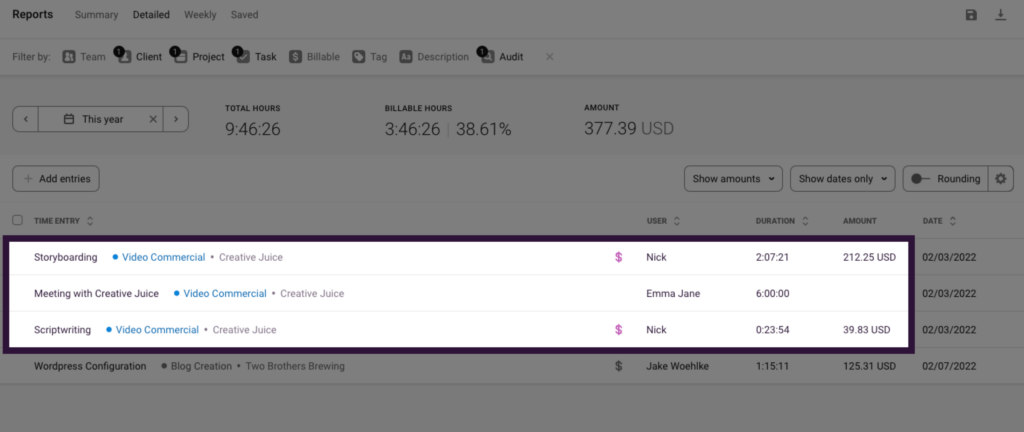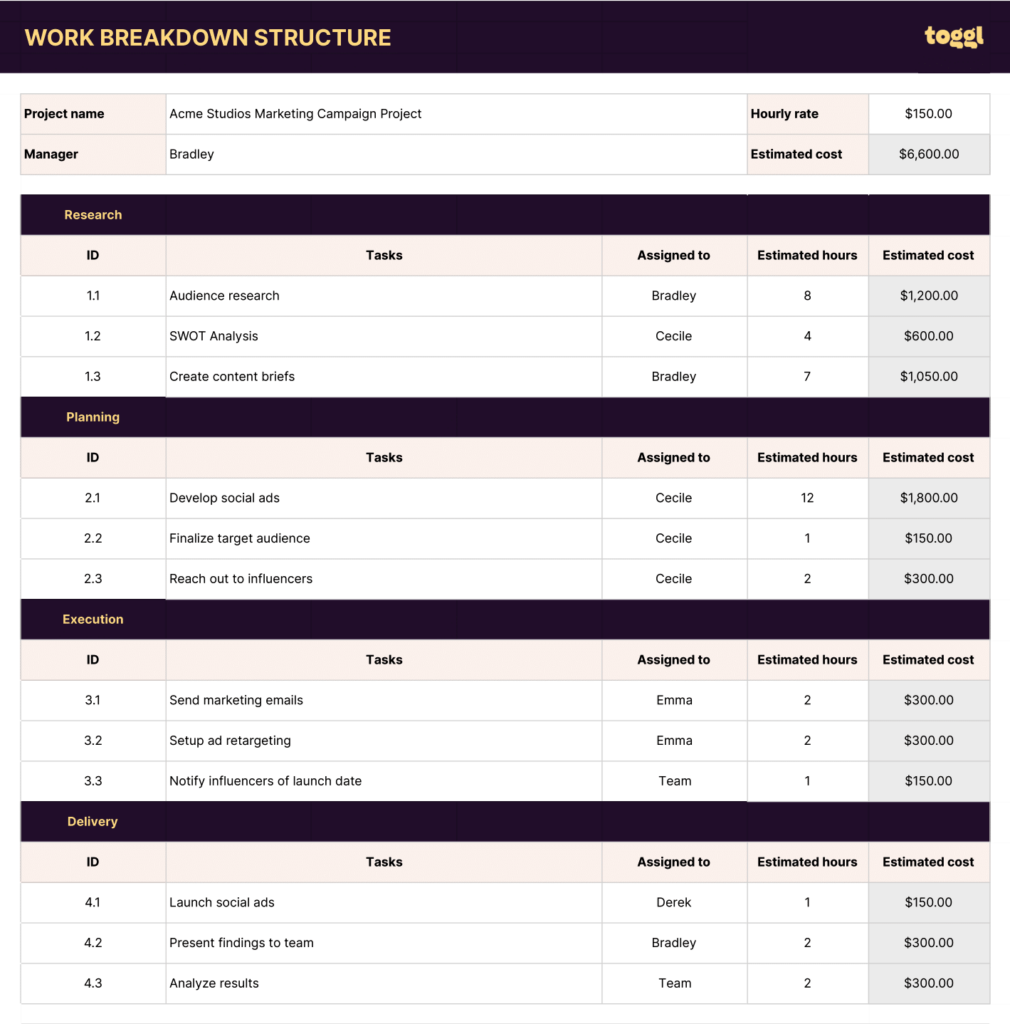Just 34% of organizations consistently get their project estimates right. That means the majority — 2 out of 3 companies — regularly overspend on their projects and bust their budgets. Not good.
From experience, I can tell you that project estimating is pretty hard. Our job as project managers is to see into the future and predict how the project will play out. But we’re not using crystal balls here, so like most things in project management, it’s best to use tried-and-tested project cost estimation techniques.
This article explores all things cost estimation. We’ll look at why it’s so important, different techniques to use, and an eight-step estimating process to forecast your next project accurately.
What is cost estimation in project management (and why is it so important)?
Project cost estimation is the process of forecasting the quantity and cost of resources required to deliver a project’s work. Accurate cost estimation goes hand-in-hand with task and schedule estimating, combining everything together to prevent overruns, boost value, and increase the chances of project success.
Accurate project estimates are the foundation of project cost management. The estimates you create as part of the project planning phase are used to secure funding, build a viable business case, and set a baseline project budget.
But that’s just the early stages of a project. While estimates are a key part of getting your project off the ground, they’re also the benchmark you’ll use for the rest of the delivery. But if you rush your estimates and get them wrong, you leave yourself open to:
- Actual costs exceeding your budget, leading to overruns and needing to request more money
- Stakeholders losing trust and confidence in your project management abilities
- Delays to project timelines, deliverables, and key milestones
- Emerging risks you don’t have the budget to address
That’s the worst-case scenario. If, instead, you use a defined cost estimating process, you’re far more likely to have the time, budget, and contingency you need to manage whatever your project throws at you — that sounds much better, right?
Project cost estimation methods
There are many tried and tested estimating techniques, methods, and templates to help project managers master the cost estimating process.
Each of these top-down and bottom-up techniques has its pros and cons and will be more or less applicable to your industry or organization, so experiment with different techniques to find what works best for you.
| Technique | Description |
|---|---|
| Analogous estimation | Looks at historical data to create a ballpark estimate |
| Top-down estimation | Looks at the overall scope and timeframe to create a high-level ballpark estimate |
| Parametric estimation | Combines data and variables to create a more accurate ballpark estimate |
| Three-point estimation | Combines the best-case scenario, the worst-case scenario, and the most likely scenario to get a realistic budget estimate |
| Bottom-up estimation | Breaks down the project into smaller tasks to create a more accurate estimate. Best for SoW estimates |
Analogous estimates
Analogous estimating involves looking at like-for-like projects you’ve completed to create an estimate for a new project. You can think of analogous estimating as the “cookie cutter” technique if your new project is the same as an old one.
Let’s look at two examples:
- Five-page website. If you’ve delivered a five-page website before for $10,000, you can rinse and repeat the same $10,000 estimate as long as the scope of work is similar.
- Construction costs. If a cost estimate for a previous 2,000-brick home was $100,000, you could reasonably assume a new 2,000-brick home built the following month would also cost around $100,000.
The issue with analogous estimates is that two projects are never quite the same, so they should only be used:
- As a high-level, top-down estimating technique
- If you have accurate cost data from a previous project
- If there are no significant differences between the old project and your current project
- If there have been no major external changes (e.g., high economic inflation)
That said, analogous estimates offer a quick and easy way to get a ballpark top-down estimate using historical data.
Parametric estimates
Parametric estimates use data from similar projects and combine them with known project variables to create an estimate for a new project. You can think of parametric estimates as the “cookie cutter plus” technique, where you apply some extra math to a standard analogous estimate. Here’s how:
- Using the previous five-page, $10,000 website example, let’s say a new client wants a 10-page website instead. A parametric estimate does the math to create a like-for-like estimate for the new, larger project. The 10-page website will probably be double the work of a five-page website, so the cost estimate would also be doubled to $20,000.
But, there are some downsides to a parametric estimate, including:
- It doesn’t account for economies of scale for certain types of costs (such as raw materials), which are crucial for construction projects.
- It assumes larger and smaller projects all have the same level of risk and complexity.
Again, like with analogous estimates, a parametric estimate is another top-down technique that’s great for fast, high-level estimates.
Analytical estimates
An analytical estimate is a bottom-up estimating technique that breaks the project down into parts and uses internal and external data sources to estimate the cost of each. This is the most scientific and accurate approach, but takes a lot more time and effort to complete.
Here’s an example of an analytical estimate in action:
- Building 50 new computers. To understand the total equipment costs, you’d break the computer down into its component parts and use an external cost benchmark to estimate the cost of each. You’d then add the cost of each part together to get a total equipment cost.
Aside from being labor-intensive, analytical estimates:
- Require large data sets to make them accurate
- Require a work breakdown structure or product breakdown structure to be completed beforehand
Analytical estimates are a great bottom-up technique for detailed, line-by-line estimates that enable reliable decision-making.
Delphi estimates
A Delphi estimate is a bottom-up estimating technique that breaks a project down into its component parts and then uses the experience and knowledge of subject-matter experts to estimate through consensus.
Here’s a real-life example:
- Alongside the materials required to build 50 new computers, a project manager must estimate the labor costs to assemble the parts. To understand the work and costs, you could bring together five expert engineers and ask them to each estimate the time and costs required, then reach a consensus to form the final estimate.
But, when using a Delphi estimate, it’s important to be aware that:
- They’re subjective, using the opinion of experts rather than objective data
- They require a detailed breakdown of the project tasks and scope to make them accurate
Delphi estimates are great for bottom-up estimating, especially when forecasting resource management costs.
How and when to use each estimating technique?
When combining top-down and bottom-up estimating techniques, it’s important to use them at the right stage of the project lifecycle — here’s how to do it:
- When you’re developing an idea and need ballpark figures without a large time investment, top-down techniques are a quick and easy way to estimate an entire project.
- When you move into the planning phase and need a granular view of expenditures, bottom-up techniques provide the detail you need to create your first business case and set your baseline project budget.
How to estimate project costs in 8 steps
While every project, organization, and industry is different, the steps you’ll take to estimate are essentially the same. Next, we’ll walk through a high-level eight-step estimating process you can use as a blueprint for any type of project.
Remember: It’s best practice to use company-specific data sets, templates, and approval flows to tailor the process to your way of working, so take the below and tweak it as needed.
1. Refine the concept and project scope
Before you think about estimating costs, you must clearly understand the project concept and scope. After all, how can you create an accurate cost estimation for something you’re not sure of?
The best way to do this is to create a high-level scope of work or a more detailed business requirements document with your client, customer, or sponsor. Getting something written down focuses and aligns stakeholders, sets expectations, and provides an audit trail to review later on.
As the project manager, your job is to facilitate this conversation, helping clients understand what they really want by challenging their thinking and suggesting new ideas.
2. Gather data from past projects
Most estimating techniques use historical data from past projects to inform future cost estimates. Historical data provides valuable insight into:
- How cost estimates and baseline budgets compared to actual project costs
- Resource utilization and workloads
- Unforeseen risks and how they were managed
- Lessons learned — especially useful for projects that failed
For most organizations, you’ll find previous project data in project management software tools, file repositories, and project closure documents. Don’t be afraid to hunt around, as the more data you have, the more accurate and reliable your cost estimates will be.
If you’re using Toggl Track, you can access the financial data of past projects within the Project Dashboard. This will show you earnings for flat rate and hourly billed projects, as well as insights into the tasks and sub-tasks that made up each cost.

3. Break down the project into phases and tasks
Detailed bottom-up estimating techniques rely on breaking the project down into smaller, more manageable parts to improve estimating accuracy.
The best way? Create a work breakdown structure (WBS). Depending on your project, you may go for a deliverable-based WBS (best for product, engineering, and mechanical projects) or a phase-based WBS (best for software, transformation, or process improvement projects.
Either way, breaking your project down enables you to estimate the specific tasks, resources, and timelines of the project, which can then be quantified with a cost.
Feel free to use our WBS template, which contains fields to enter each task’s estimated hours and costs. Once filled out, this will create an estimated cost estimate for the entire project.
4. Calculate the cost for each task
Ready to put those estimating techniques to good use? With the work clearly defined, it’s time to work through and estimate your project. It’s important to get your cost allocation right, so consider all the different types of project costs that make up each task, including:
- Labor: The people who will work on the project tasks (applicable to all projects)
- Materials: The raw materials that you’ll use to make products (most applicable to manufacturing projects)
- Equipment: The equipment you’ll need to perform each task (most applicable to construction, manufacturing, or IT projects)
- Overheads: Any costs for premises, utilities, or software to support project activities (applicable to all projects)
Consider using various top-down and bottom-up techniques to ensure you consider every angle. Lean on the expertise of team members familiar with similar projects to sense-check the math.
As we mentioned at the beginning of this article, cost estimates will form the foundation of your entire project, so take your time and don’t rush to get to the right numbers.

By splitting the project into individual phases and tasks, you’ll better understand how the project fits together to form the whole. And when divided into smaller parts, it also makes it much easier for your team to estimate how much effort will be required to produce it.
When it comes to tracking project costs, you will be able to track expenditures against specific project phases rather than lump them all together.
But this process can take time, so don’t do this for a ballpark estimate. It makes more sense to do this when you know the client has the budget and needs more detail from you.
Using Toggl Track, you can view past project task data within the Reports Dashboard to better understand what time and costs went into each task.

This is useful for quickly coming up with a budget estimate for a project when the client wants a little more detail.
It’s worth noting that project cost estimates often need to be adjusted during the discovery phase — especially on long and complicated projects. However, using a WBS and past historical project data should help you to create far more accurate cost estimates.
5. Tackle optimism bias with a three-point estimate
Human beings are naturally optimistic people, and this is especially true when it comes to estimating projects. Most cost overruns come from a tendency to be naturally optimistic, so I’d recommend using a three-point estimate to tackle your optimism bias. Here’s how it works:
- Three-point estimating combines the best-case, worst-case, and most likely outcome to create an accurate, weighted estimate.
- When estimating any cost, use this formula to give a balanced estimate of the most likely outcome: Estimate = (Best Case + 4 x Most Likely + Worst Case) / 6
- Let’s jump back to our 2,000 bricks example from earlier. Let’s say the best price was estimated at $20,000, the worst price at $30,000, but the most likely was $22,000. Using a weighted 3-point estimate, you’d estimate $23,000 as your final 3-point estimate.
A three-point estimate is a classic project estimating technique that combats optimism bias and adds a little contingency to cover you for emergencies.
6. Add a project buffer to protect profits
Projects are uncertain places to operate, and things can go wrong at any time. To protect you, your estimates, and your project’s profits, add some contingency for unexpected risks and expenses.
As a general rule, there are two ways to add project contingency to your estimates:
- Line-by-line percentage: Once you’ve estimated each cost item, add a fixed percentage (e.g., 5%) to every cost
- Contingency cost: Add a one-off contingency cost to your total project estimate (e.g., $10,000)
To determine which type of contingency to use and how much to add, evaluate your project’s complexity and risk factors (higher complexity/risk = more buffer), then review historical data from past project budgets.
7. Don’t forget hidden costs
Where most project managers go wrong is they format hidden costs that don’t necessarily fall out of a work breakdown structure. Some of the most common costs include:
- Regulatory or compliance fees, e.g., insurances, professional memberships, audits
- Training, e.g., upskilling/cross-skilling team members and end users
- Maintenance, e.g., maintaining equipment, software licenses
- Contractual, e.g., exit costs, signing fees, variable costs
- Marketing, e.g., communications, advertisement, social media
- Financial, e.g., loan fees, interest rates, repayment charges
This is where historical data and expert insights ensure you haven’t missed any significant expenses in your total project costs.
8. Calculate the total cost of the project
To finish, aggregate all of those individual tasks and costs together to determine the total project budget.
This includes your individual estimates, your contingencies, and any hidden costs to paint the full picture. As a final check, include both direct costs (e.g., labor, materials) and indirect costs (e.g., administrative expenses), as well as any variable costs that might change as your project expands (e.g., utilities, software licenses).
Once you’re happy you’ve considered all the costs, link them back to your work breakdown structure ready to share with your stakeholders. It will look something like this.👇

What most project managers get wrong with project cost estimating
When the pressure of a high-speed project is on, it’s easy to make silly mistakes in the project cost estimating process. Here are some of the most common pitfalls project managers make and how you can avoid them:
Bad math
Estimating is a numbers game, and when you rush it, you’re likely to get your numbers wrong. To avoid this, team up with a finance or audit department colleague to double-check your work or use proper estimating software to iron out mistakes.
Underestimating complexity
Projects are inherently complex, but many project managers make the mistake of trying to oversimplify things. Take this too far, and you’re at risk of underestimating, leaving yourself with a budget problem down the line. Use the 3-point technique to create a weighted estimate and avoid limiting your budget.
Forgetting buffer
All estimates are essentially educated guesses, so make sure you always include some room for error. When project managers forget buffers, they inevitably end up getting caught out when things don’t quite go to plan.
Use Toggl Track to track and control project costs
If you need some help creating, monitoring, and controlling project costs, Toggl Track is the best friend you didn’t know you had! With features for resource management, time tracking, and reporting and analytics, you can set a cost estimate and accurately track how your actual costs perform against budget.
Toggl Track’s intuitive interface makes the experience effortless, while helping you seamlessly incorporate cost estimates into your workflows. Bring all this together, and you’ll build stakeholder trust, enable informed decision-making, and improve your chance of project success.
Like the sound of that? Try Toggl Track for free and see for yourself how we make managing project costs a walk in the park.
James Elliott is an APMQ and MSP-certified project professional and writer from London. James has 8 years' experience leading projects and programs for tech, travel, digital, and financial services organizations, managing budgets in excess of £5m and teams of 30+. James writes on various business and project management topics, with a focus on content that empowers readers to learn, take action, and improve their ways of working. You can check out James’ work on his website or by connecting on LinkedIn.





![What is Project Resource Management? [Comprehensive Guide]](https://toggl.com/blog/wp-content/uploads/2021/10/project-resource-management-112x67.jpg)



